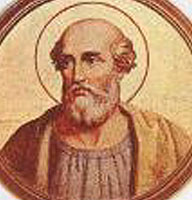Next in the continuing series of posts on the History of the Sovereign Pontiffs, after the death of Pope St. Urban I in 230, St. Pontian was elected as the Supreme Pontiff.
He devoted much of his reign to upholding the condemnation of the heretical aspects of Origenism and struggled against the schismatic movement which supported the antipope Hippolytus. In 235, Pontian was arrested by Roman officials at the instigation of the persecution of the Church by Emperor Maximinus I Thrax. With Hippolytus, Pontian was exiled to the infamous mines of Sardinia. In order to make certain that the Church was not deprived of its leadership while he was in exile, St. Pontian stepped down, the first pope ever to do so, so that a new successor could govern the People of God. Both he and Hippolytus both died on Sardinia. Their remains were returned to Rome under Pope St. Fabian.
Interestingly, Hippolytus is also a saint and a source of inspiration for us to pray for the conversion of those in schism. When St. Callistus was elected pope, St. Hippolytus accused him of being too lenient with penitents and had himself elected antipope by a group of followers. He felt that the Church must be composed of pure souls uncompromisingly separated from the world: St. Hippolytus evidently thought that his group fitted the description. He remained in schism through the reigns of three popes until 235 when he also was banished to the island of Sardinia. Shortly before or after this event, he was reconciled to the Church and died in exile with Pope St. Pontian.
Regarding the heresy of Origenism, which was led by Origen, a Church Father, who despite his piety and great learning in some respect, ultimately fell away from the Truth.
Thus, we see in the lives of those around St. Pontian the schismatic who is reconciled as well as the Church Father who is lost. And in St. Pontian we see a man who stayed firm throughout. It all matters how we end - the state of our soul at death determines our eternal destiny. So let us pray for the conversion of all and not worry on our past sins which have been forgiven in confession. Our only goal should be to press ahead to Heaven by staying close to the Church, the Sacraments, the Holy Sacrifice of the Mass, and interior conversion.
St. Pontian, pray for us!
Read more >>
Commemoration (1954 Calendar): November 19
Pope St. Pontian reigned as the Vicar of Christ on earth from 230-235. He holds the distinction of being the first pontiff to abdicate - one of only a few popes to have ever resigned the Holy Office.
He devoted much of his reign to upholding the condemnation of the heretical aspects of Origenism and struggled against the schismatic movement which supported the antipope Hippolytus. In 235, Pontian was arrested by Roman officials at the instigation of the persecution of the Church by Emperor Maximinus I Thrax. With Hippolytus, Pontian was exiled to the infamous mines of Sardinia. In order to make certain that the Church was not deprived of its leadership while he was in exile, St. Pontian stepped down, the first pope ever to do so, so that a new successor could govern the People of God. Both he and Hippolytus both died on Sardinia. Their remains were returned to Rome under Pope St. Fabian.
Interestingly, Hippolytus is also a saint and a source of inspiration for us to pray for the conversion of those in schism. When St. Callistus was elected pope, St. Hippolytus accused him of being too lenient with penitents and had himself elected antipope by a group of followers. He felt that the Church must be composed of pure souls uncompromisingly separated from the world: St. Hippolytus evidently thought that his group fitted the description. He remained in schism through the reigns of three popes until 235 when he also was banished to the island of Sardinia. Shortly before or after this event, he was reconciled to the Church and died in exile with Pope St. Pontian.
Regarding the heresy of Origenism, which was led by Origen, a Church Father, who despite his piety and great learning in some respect, ultimately fell away from the Truth.
Thus, we see in the lives of those around St. Pontian the schismatic who is reconciled as well as the Church Father who is lost. And in St. Pontian we see a man who stayed firm throughout. It all matters how we end - the state of our soul at death determines our eternal destiny. So let us pray for the conversion of all and not worry on our past sins which have been forgiven in confession. Our only goal should be to press ahead to Heaven by staying close to the Church, the Sacraments, the Holy Sacrifice of the Mass, and interior conversion.
St. Pontian, pray for us!
Collect:
We have offered our gifts to You, O Lord. Let Your light graciously shine upon Your Church, so that this flock may everywhere prosper, and its pastors under Your guidance, may be truly pleasing to You. Through our Lord . . .


























